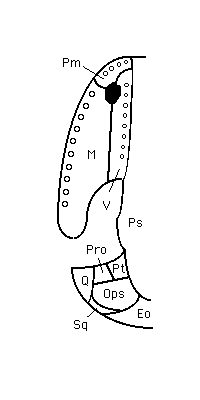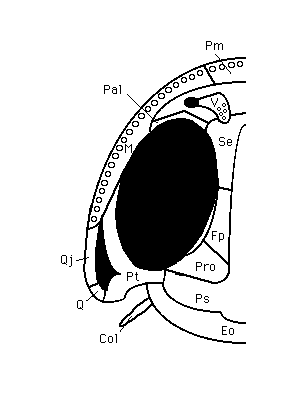| MadSci Network: General Biology |
Teeth along the palate (the ventral surface of the upper jaw) are common in a variety of (especially) primitive vertebrates. For example, they are present in most lizards, their loss being characterstic of geckos. The only bones carrying the teeth of mammals and "higher" vertebrates are the maxilla (plural maxillae) and the premaxilla (pl. premaxillae). However, in other vertebrate, teeth may be developed on any of the upper jaw bones. For example, one of the most primitive known fossil amphibians, Icthyostega, has two rows of teeth along each side of the jaw, the outer row are "normal" teeth on the maxillae and premaxilla, the inner row palatal teeth on the ectopterygoid, palatine and vomer bones. The vomerine teeth of frogs are much reduced compared to the palatal teeth of many reptiles, amphibians and fish, and may therefore be seen as, in some sense, vestigial and functionally rather unimportant, being much reduced compared to the functionally important palatal teeth in ancestral amphibians - akin to the vestigial appendix of humans. Palatine teeth in general are used to grip prey in the mouth. The primitive vertebrate feeding method uses only the head and jaw to grab prey and swallow it whole, often alive. You've probably seen natural history footage of snakes feeding in this way. These animals do not have jaws that allow them to chew. When feeding like this, more teeth give a better grip on the struggling prey. In mammals and other vertebrates without palatal teeth, a different method is used to feed. For example, in big cats like the lion the prey is killed first and then ripped up and swallowed in chunks. In this situation, the teeth are adapted for killing and cutting, rather than gripping, and so extra palatal teeth are not necessary. Similarly, there is little need for a frog's teeth to grip the prey, since the invertebrate food is captured using a sticky tongue and will usually fit whole inside the mouth and therefore cannot struggle free before being swallowed. The frog now has little use for palatal teeth and so most species have very small, sparse vomerine teeth.

Figure 1. Simplified ventral view of half salamander skull showing long row of strong palatal teeth on vomer (indicated by open circles). Abbreviations: premaxilla (Pm), maxilla (M), vomer (V), parasphenoid (Ps), pterygoid (Pt), prootic (Pro), quadrate (Q), opisthotic (Ops), squamosal (Sq), exoccipital (Eo).

Figure 2. Simplified ventral view of half frog skull showing weak palatal teeth on vomer. Abbreviations as above, plus: sphenethmoid (Se), quadratojugal (Qj), columella (Col).
References
Links
Try the links in the MadSci Library for more information on General Biology.